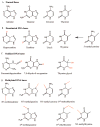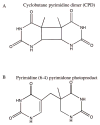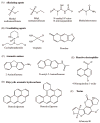Mechanisms of DNA damage, repair, and mutagenesis
- PMID: 28485537
- PMCID: PMC5474181
- DOI: 10.1002/em.22087
Mechanisms of DNA damage, repair, and mutagenesis
Abstract
Living organisms are continuously exposed to a myriad of DNA damaging agents that can impact health and modulate disease-states. However, robust DNA repair and damage-bypass mechanisms faithfully protect the DNA by either removing or tolerating the damage to ensure an overall survival. Deviations in this fine-tuning are known to destabilize cellular metabolic homeostasis, as exemplified in diverse cancers where disruption or deregulation of DNA repair pathways results in genome instability. Because routinely used biological, physical and chemical agents impact human health, testing their genotoxicity and regulating their use have become important. In this introductory review, we will delineate mechanisms of DNA damage and the counteracting repair/tolerance pathways to provide insights into the molecular basis of genotoxicity in cells that lays the foundation for subsequent articles in this issue. Environ. Mol. Mutagen. 58:235-263, 2017. © 2017 Wiley Periodicals, Inc.
Keywords: base excision repair; mismatch repair; nucleotide excision repair; single and double strand break repair; telomeres; translesion synthesis.
© 2017 Wiley Periodicals, Inc.
Conflict of interest statement
There are no conflicts of interests.
Figures




References
-
- Adamo A, Collis SJ, Adelman CA, Silva N, Horejsi Z, Ward JD, Martinez-Perez E, Boulton SJ, La Volpe A. Preventing nonhomologous end joining suppresses DNA repair defects of Fanconi anemia. Mol Cell. 2010;39(1):25–35. - PubMed
-
- AEP . In: DNA repair and carcinogenesis by alkylating agents. CCaG PL, editor. Berlin: Springer; 1990. pp. 103–131.
-
- Ahel I, Rass U, El-Khamisy SF, Katyal S, Clements PM, McKinnon PJ, Caldecott KW, West SC. The neurodegenerative disease protein aprataxin resolves abortive DNA ligation intermediates. Nature. 2006;443(7112):713–716. - PubMed
-
- Akbari M, Pena-Diaz J, Andersen S, Liabakk NB, Otterlei M, Krokan HE. Extracts of proliferating and non-proliferating human cells display different base excision pathways and repair fidelity. DNA Repair (Amst) 2009;8(7):834–843. - PubMed
-
- Akbari M, Visnes T, Krokan HE, Otterlei M. Mitochondrial base excision repair of uracil and AP sites takes place by single-nucleotide insertion and long-patch DNA synthesis. DNA Repair (Amst) 2008;7(4):605–616. - PubMed
Publication types
MeSH terms
Grants and funding
LinkOut - more resources
Full Text Sources
Other Literature Sources

